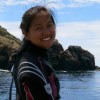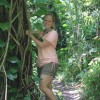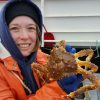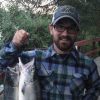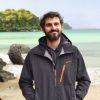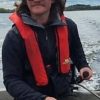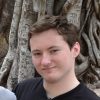Past Postdoctoral Fellow
Charlotte (PhD 2012) was a University of Washington postdoctoral researcher based at NOAA’s Southwest Fisheries Science Center. Her research focuses on investigating the spatial ecology of highly-mobile long-lived marine vertebrate species and identifying areas that are important for their conservation. Her research interests center on understanding how the observed seasonal distribution and movement patterns of highly-mobile long-lived marine vertebrates (such as seabirds and cetaceans) relate to the abundance and distribution of prey and underlying physical and biological habitat features; and how spatial and temporal variability in habitat features and ecological processes influences the foraging success, reproductive performance, and survival of these species.
Charlotte’s PhD research was motivated by questions about the potential for marine protected areas and fisheries management to safeguard prey availability for seabirds and other central place foragers. She developed a spatially-explicit individual-based model to investigate the effects of changes in the abundance and distribution of prey on the foraging ecology of two species of seabird, the Peruvian Booby (Sula variegata) and Guanay Cormorant (Phalacrocorax bougainvilliorum). The results of this research demonstrated that prey depth can be more important than abundance in predicting the foraging success of depth-limited seabirds, and provided insights into the effectiveness of area closures and broad-scale reductions in fishing effort for safeguarding prey availability for seabirds and pinnipeds.
Since finishing her PhD, Charlotte completed a National Research Council Postdoctoral Research Associateship to estimate the levels of extinction risk for species previously determined to be endangered, threatened, or not warranted for listing under the U.S. Endangered Species Act. The purpose of this retrospective analysis was to inform development of a decision framework to strengthen the consistency and transparency of ESA listing decisions.
Current research projects focus on developing methods for estimating and predicting distribution patterns at relatively fine spatial and temporal scales by integrating various types of data, such as distance-sampling and spatial capture-recapture data.
Publications
- Boyd, C, Barlow, J, Becker, EA, Forney, KA, Gerrodette, T, Moore, JE, Punt, AE. 2017. Estimation of population size and trends for highly mobile species with dynamic spatial distributions. Divers. Distributions 00:00-00. doi:10.1111/ddi.12663.
- Boyd, C, Castillo, R, Hunt, G, Punt, A, VanBlaricom, G, Weimerskirch, H, Bertrand, S. 2015. Predictive habitat modeling of marine predators in relation to the abundance and depth distribution of pelagic prey. J. Anim Ecol 84(6):1575-1588. DOI: 10.1111/1365-2656.12409
- Curtis, KA, Moore, JE, Boyd, C, Dillingham, PW, Lewison, RL, Taylor, BL, James KC. 2015. Managing catch of marine megafauna: guidelines for setting limit reference points. Mar Pol 61:249-263. DOI:10.1016/j.marpol.2015.07.002
- Boyd, C., M. Woillez, S. Bertrand, R. Castillo, A. Bertrand, and A. Punt. 2015. Bayesian posterior prediction of the patchy spatial distributions of small pelagic fish in regions of suitable habitat. CJFAS 72:290-303. DOI:10.1139/cjfas-2014-0234
- Boyd, C. 2014. Minimizing seabird by-catch in industrial fisheries. Animal Conservation 17: 530-531. DOI:10.1111/acv.12179
- Boyd, C, Punt, A, Weimerskirch, H, Bertrand, S. 2014. Movement models provide insights into variation in the foraging effort of central place foragers. Ecol Model 286:13-25. DOI:10.1016/j.ecolmodel.2014.03.015
- Boyd, C, Brooks, TM, Butchart, SHM, Edgar, GJ, da Fonseca, GAB, Hawkins, F, Hoffmann, M, Sechrest, W, Stuart, SN, van Dijk, PP. 2008. Spatial scale and the conservation of threatened species. Cons Lett 1:37-43. DOI:10.1111/j.1755-263X.2008.00002.x
- Boyd, C. 2012. The Predator’s Dilemma: Investigating the responses of seabirds to changes in the abundance and distribution of small pelagic prey. Ph.D. dissertation, School of Aquatic and Fishery Sciences, University of Washington, Seattle, WA.


